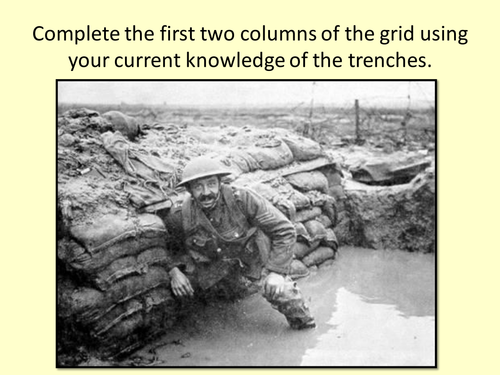



This is a full lesson with resources based on trench warfare of World War 1, aimed at a higher ability set.
Before I teach this lesson, I teach one lesson on the Trenches to give some background, so students are able to complete the KWL grid starter for this lesson.
The lesson is based on the Student Organised Learning Environment model of learning, and as such, it is an independent learning lesson. The teacher takes a back seat role and becomes a facilitator or monitor.
The activity can be differentiated easily, through giving groups of students aspects for the trenches to look at, for example food or social time. The activity lends itself well to higher ability students, as I generally ask them to set themselves some questions in the second column of the KWL grid that they can investigate within the lesson. This means students are able to shape their own learning.
I ask students to present their research on large pieces of sugar paper, which are then put on display afterwards. I also encourage students to copyright their ideas (initials in a circle next to their input) to ensure all group members contribute.
The lesson was observed and rated outstanding, under the old OFSTED guidelines.
Before I teach this lesson, I teach one lesson on the Trenches to give some background, so students are able to complete the KWL grid starter for this lesson.
The lesson is based on the Student Organised Learning Environment model of learning, and as such, it is an independent learning lesson. The teacher takes a back seat role and becomes a facilitator or monitor.
The activity can be differentiated easily, through giving groups of students aspects for the trenches to look at, for example food or social time. The activity lends itself well to higher ability students, as I generally ask them to set themselves some questions in the second column of the KWL grid that they can investigate within the lesson. This means students are able to shape their own learning.
I ask students to present their research on large pieces of sugar paper, which are then put on display afterwards. I also encourage students to copyright their ideas (initials in a circle next to their input) to ensure all group members contribute.
The lesson was observed and rated outstanding, under the old OFSTED guidelines.
Something went wrong, please try again later.
This resource hasn't been reviewed yet
To ensure quality for our reviews, only customers who have purchased this resource can review it
Report this resourceto let us know if it violates our terms and conditions.
Our customer service team will review your report and will be in touch.
£2.00
